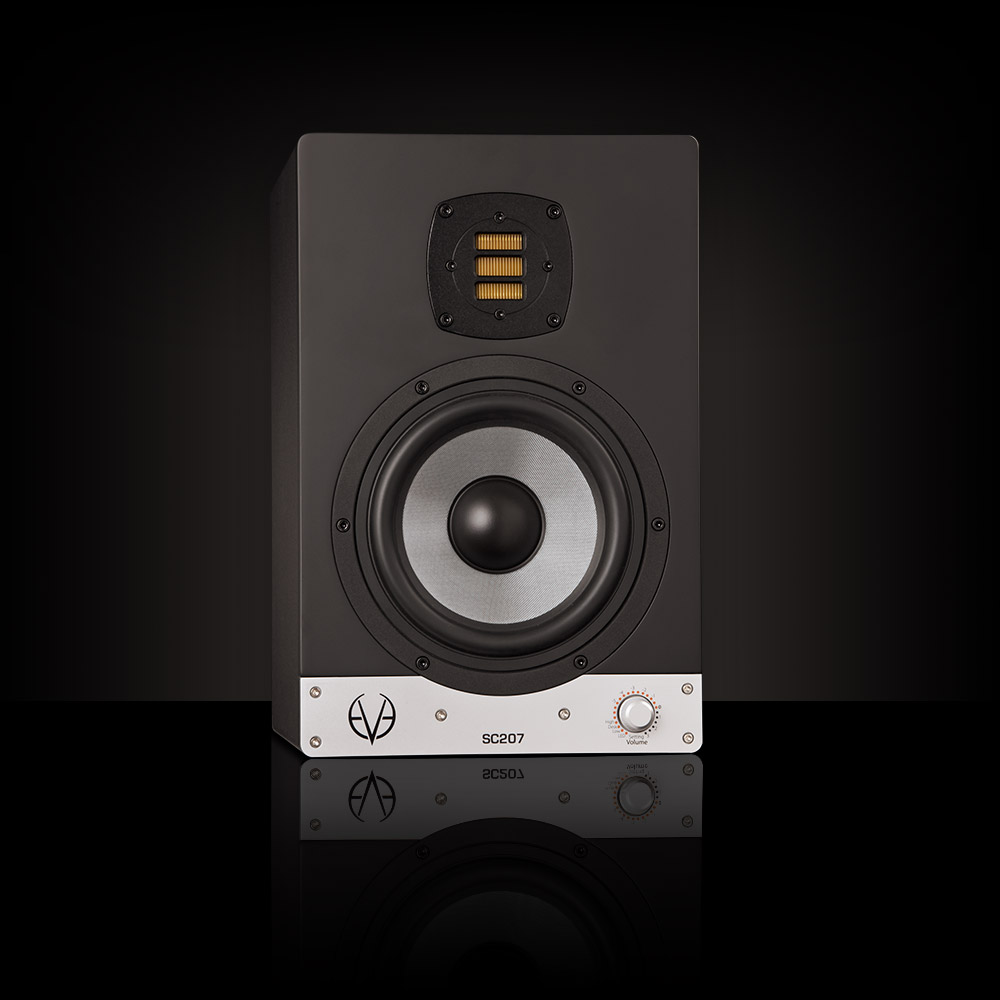Current customs want you to spend less time in front of the HiFi system in the living room and more hours sitting at your desk than in the past. It is not said that in this case we must give up the quality of music reproduction: using good nearfield monitors (IE. close listening), we can continue to get excited with quality reproduction. This type of bookshelf comes directly from the pro sector and with the EVE Audio SC207 you can get extremely convincing results at a reasonable price.
By Paolo Perilli
“In my work as an editor of music reproduction equipment, I have always had a preference for low budget solutions that would allow to obtain satisfactory results based on the much sought after quality / price ratio. For my personal curiosity and for work reasons, for several years my attention has been captured by devices that do not belong to the HiFi world but to that of professional audio. This sector is dominated by mechanisms quite different from the Home one and my experience leads me to say that often and willingly the quality / price ratio of many equipment is superior and more generally really excellent as in the case of the monitors covered by this article: the EVE Audio SC207”.
EVE Audio: the beginning
Eve Audio has a relatively short history, but, as we will see, it has a solid technical foundation. It was founded in 2011 in Germany in Berlin by Roland Stenz, someone with extensive experience in the world of electronics since the 80s. but known above all for having created in 1999 the ADAM Audio, a well-known manufacturer of excellent and appreciated professional monitors. In 2010, Stenz left the company and decided to create a new brand, in direct competition with the previous one and for obvious irony decided to call it EVE (Adam and Eve). The EVE Audio project depends heavily on Stenz’s experience with ADAM and it is normal that the products of the two brands have aspects in common. Let’s start by saying that the most commercially successful product of ADAM Audio have long been the A7X monitors that (coincidentally) are the direct competitors of the speakers we talk about in this article. Let’s try to understand what are the functions of a nearfield monitor with a 7-inch woofer (such as the A7X and the EVE Audio SC207). The various stages of making a musical product are more or less three: recording, mixing and mastering. Nearfield monitors are mainly used in the first two. In both, the position of the technician is in front of the console, on which (or just behind) are the speakers prepared precisely to monitor the recording and / or mixing phases. The term nearfield indicates the predisposition to a particularly close listening (1-2 meters at max) distance within which this kind of instrument must express the maximum of its potential. Generally, these monitors never have important dimensions and the woofers used have a limited diameter (max 8 inches) just to facilitate close positioning. But also, and above all, to maintain a phase consistency in the nearby field that would be lost with more bulky speakers. There are various theories in this regard but, from my point of view, nearfield monitors must necessarily be revealing to allow you to easily identify any mixing or recording errors and at the same time they should be as timbrically neutral as possible so as not to mislead the technician in search of a general balance. But isn’t that exactly what every audiophile looks for from their speakers for “simple” listening? From this assumption comes my interest in this category of speakers that, in addition to being a work tool, can give many satisfactions to those who understand music only as leisure.
Technique
The EVE Audio SC207 are active nearfield monitors (therefore amplified) that have several features in common with the aforementioned ADAM A7X, for several years, considered a best buy of the middle class and much appreciated by many professionals. First of all, the size of the woofer loaded in Bass Reflex which, as we have said, is 7 inches nominal in diameter (actually that of the EVE Audio is 6.5 inches – 16.5 cm); then both provide for the presence of an AMT tweeter, a particular transducer invented by Oskar Heil that stands out from both the most common electrodynamic and electrostatic speakers; both use 100 W rms PWM (Pulse Width Modulation) digital amplifiers to drive the woofer, while for the tweeter the Adams use a 50 W class A/B amp and the EVE Audio another 50 W PWM. The features in common between the two products end here because the SC207, in addition to costing a little less (about 450 euros against 500 euros for a single monitor) have very interesting and also innovative aspects that the most conservative ADAM monitors do not have.
Among the most original and salient features, the EVE Audio SC207 (as indeed all the monitors of the same house) provide a BurrBrown (24 bit / 192kHz) that takes the analog signal from the RCA or XLR inputs (balanced) to then pass it in numerical form to a proprietary DSP that has the primary function of crossover filtering, protection from too high impulsive signals and correction of the frequency response. As we will see in the section dedicated to use and listening, the DSP allows you to finely adjust different aspects of the sound through the characteristic multifunction knob on the front of each speaker. Another interesting technical aspect is that of the particular shape of the reflex duct (located in the back of the cabinet) which would allow, according to the manufacturer, to limit the classic distortions deriving from the use of this loading technology.
Use & listening
The EVE Audio SC207 have dimensions quite aligned with those of other monitors that use 7-inch woofers and are therefore quite easy to place in the environment and especially in front of your workstation. In my case I have a piece of furniture just behind the desk, with shelves on which I normally place the monitors. In this configuration the listening distance is about one and a half meters to form an equilateral triangle between the head and the speakers. Personally, I don’t really like to place the speakers directly on the desk, partly for reasons of space, partly because the reflections of the piano heavily affect the frequency response around the medium bass. It must be said that the vast majority of professional monitors allow you to set special equalization to compensate for this coloring. In the specific case of the SC207, through the multifunction knob on the front, it is possible to manage this aspect through a Desk Filter able to enhance the frequencies around 80 Hz by max 3db or to attenuate those around 170 Hz by max 5db; a decidedly original approach compared to the competition that often limits itself to proposing a high-pass or bell-shaped filter on a single frequency. The same knob allows you to manage the volume of each monitor; to manage high frequencies (-5dB – +3dB starting from 3kHz); low frequencies (-5dB – +3dB starting from 300Hz) and to change the type of lighting of the LEDs. On the back we find two connection possibilities: the usual unbalanced RCA or the balanced XLR sockets; they do not accept 1/4 inch balanced TRS Jack connectors. Just above the audio connections we find the switches that allow you to “freeze” volume and any equalization chosen regardless of the use of the knob on the front.
The SC207 presents itself with an aesthetic that we could consider austere; the diffuser is black and the only characterization provided is that of the yellow ribbon of the AMT tweeter and a small aluminum panel forged from solid positioned at the bottom of the front, which shows the logo, model name and the aforementioned multifunction knob. The general tactile sensation is that of a well-designed monitor, also thanks to the non-resonance of the cabinet (quite deaf if hit with the knuckles of the fingers) and the considerable weight: 8Kg. As is customary for this type of professional equipment, there are no protective nets for transducers, but EVE Audio provides, specifically for the delicate tweeter, a sort of magnetic protective grid (which I preferred not to use). To prevent the speakers from transmitting vibrations to the bookcase shelf, I decided to decouple the monitors by interposing two sheets of foam about 1 cm high.
Just before the arrival of these SC207, I had the opportunity to try other active monitors in the same location: the JBL 305P MKII, the Fluid Audio FX8, the KRK Rokit RP7 G4 and finally the Eve Audio SC205. All speakers are quite different in sound setting, technical characteristics and price range. The JBL are, in my opinion, a Best Buy of the economic range (about 300 eur the pair) with digital amplification and 5-inch woofer; the Fluid Audio, characterized by a class AB amplification. 8-Inch woofers and concentric dome tweeters, have an excellent emission consistency but some too much coloring (among other things, they do not offer any possibility of adjustment apart from the volume); the KRK are another Best Buy of the economic range with 7-inch woofers (they are just under 400 euros the pair) although in my opinion characterized by a sound perhaps too “dry”. After krk I installed the Eve Audio SC205 which has a woof


